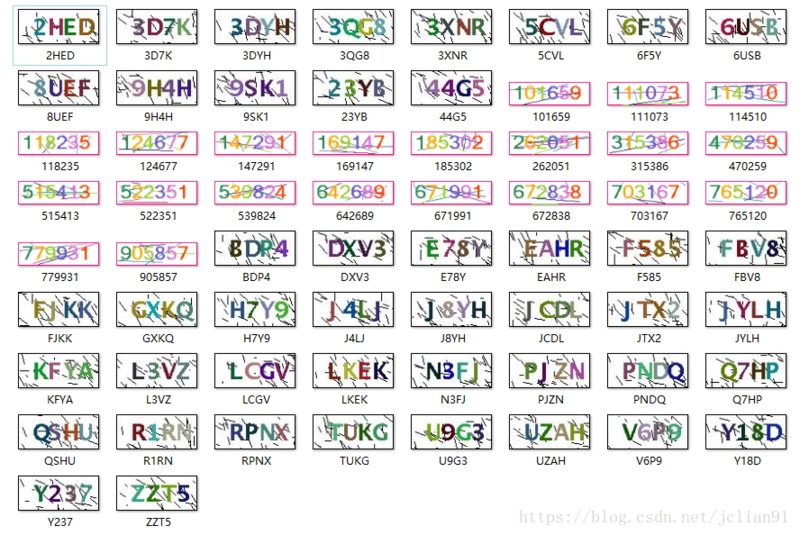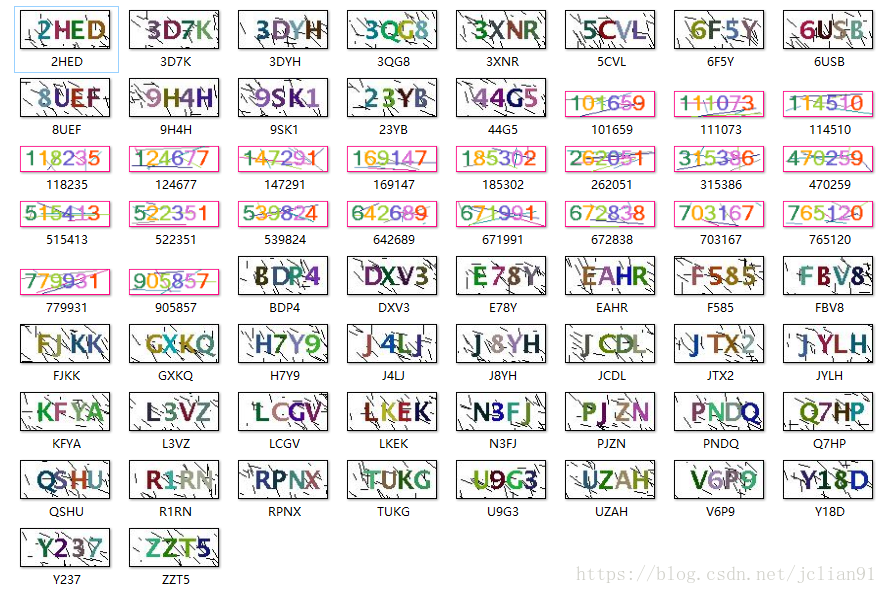图片验证码识别
我们在网上浏览网页或注册账号时,会经常遇到验证码(CAPTCHA),如下图:
本文将具体介绍如何利用Python的图像处理模块pillow和OCR模块pytesseract来识别上述验证码(数字加字母)。
我们识别上述验证码的算法过程如下:
- 将原图像进行灰度处理,转化为灰度图像;
- 获取图片中像素点数量最多的像素(此为图片背景),将该像素作为阈值进行二值化处理,将灰度图像转化为黑白图像(用来提高识别的准确率);
- 去掉黑白图像中的噪声,噪声定义为:以该点为中心的九宫格的黑点的数量小于等于 4;
- 利用 pytesseract 模块识别,去掉识别结果中的特殊字符,获得识别结果。
我们的图片如下(共 66 张图片):

完整的 Python 代码如下:
import os
import pytesseract
from PIL import Image
from collections import defaultdict
# tesseract.exe所在的文件路径
pytesseract.pytesseract.tesseract_cmd = 'C://Program Files (x86)/Tesseract-OCR/tesseract.exe'
# 获取图片中像素点数量最多的像素
def get_threshold(image):
pixel_dict = defaultdict(int)
# 像素及该像素出现次数的字典
rows, cols = image.size
for i in range(rows):
for j in range(cols):
pixel = image.getpixel((i, j))
pixel_dict[pixel] += 1
count_max = max(pixel_dict.values()) # 获取像素出现出多的次数
pixel_dict_reverse = {v:k for k,v in pixel_dict.items()}
threshold = pixel_dict_reverse[count_max] # 获取出现次数最多的像素点
return threshold
# 按照阈值进行二值化处理
# threshold: 像素阈值
def get_bin_table(threshold):
# 获取灰度转二值的映射table
table = []
for i in range(256):
rate = 0.1 # 在threshold的适当范围内进行处理
if threshold*(1-rate)<= i <= threshold*(1+rate):
table.append(1)
else:
table.append(0)
return table
# 去掉二值化处理后的图片中的噪声点
def cut_noise(image):
rows, cols = image.size # 图片的宽度和高度
change_pos = [] # 记录噪声点位置
# 遍历图片中的每个点,除掉边缘
for i in range(1, rows-1):
for j in range(1, cols-1):
# pixel_set用来记录该店附近的黑色像素的数量
pixel_set = []
# 取该点的邻域为以该点为中心的九宫格
for m in range(i-1, i+2):
for n in range(j-1, j+2):
if image.getpixel((m, n)) != 1: # 1为白色,0位黑色
pixel_set.append(image.getpixel((m, n)))
# 如果该位置的九宫内的黑色数量小于等于4,则判断为噪声
if len(pixel_set) <= 4:
change_pos.append((i,j))
# 对相应位置进行像素修改,将噪声处的像素置为1(白色)
for pos in change_pos:
image.putpixel(pos, 1)
return image # 返回修改后的图片
# 识别图片中的数字加字母
# 传入参数为图片路径,返回结果为:识别结果
def OCR_lmj(img_path):
image = Image.open(img_path) # 打开图片文件
imgry = image.convert('L') # 转化为灰度图
# 获取图片中的出现次数最多的像素,即为该图片的背景
max_pixel = get_threshold(imgry)
# 将图片进行二值化处理
table = get_bin_table(threshold=max_pixel)
out = imgry.point(table, '1')
# 去掉图片中的噪声(孤立点)
out = cut_noise(out)
#保存图片
# out.save('E://figures/img_gray.jpg')
# 仅识别图片中的数字
#text = pytesseract.image_to_string(out, config='digits')
# 识别图片中的数字和字母
text = pytesseract.image_to_string(out)
# 去掉识别结果中的特殊字符
exclude_char_list = ' .:\\|\'\"?![],()~@#$%^&*_+-={};<>/¥'
text = ''.join([x for x in text if x not in exclude_char_list])
#print(text)
return text
def main():
# 识别指定文件目录下的图片
# 图片存放目录figures
dir = 'E://figures'
correct_count = 0 # 图片总数
total_count = 0 # 识别正确的图片数量
# 遍历figures下的png,jpg文件
for file in os.listdir(dir):
if file.endswith('.png') or file.endswith('.jpg'):
# print(file)
image_path = '%s/%s'%(dir,file) # 图片路径
answer = file.split('.')[0] # 图片名称,即图片中的正确文字
recognizition = OCR_lmj(image_path) # 图片识别的文字结果
print((answer, recognizition))
if recognizition == answer: # 如果识别结果正确,则total_count加1
correct_count += 1
total_count += 1
print('Total count: %d, correct: %d.'%(total_count, correct_count))
'''
# 单张图片识别
image_path = 'E://figures/code (1).jpg'
OCR_lmj(image_path)
'''
main()
运行结果如下:
('101659', '101659')
('111073', '111073')
('114510', '114510')
('118235', '118235')
('124677', '124677')
('147291', '147291')
('169147', '169147')
('185302', '185302')
('23YB', '23YB')
('262051', '262051')
('2HED', '2MED')
('315386', '315386')
('3D7K', '3D7K')
('3DYH', '3DYH')
('3QG8', '30G8')
('3XNR', 'EXNR')
('44G5', '44G5')
('470259', '470259')
('515413', '515413')
('522351', '522351')
('539824', '539824')
('5CVL', 'SCVL')
('642689', '642689')
('671991', '671991')
('672838', '672838')
('6F5Y', '6F5Y')
('6USB', 'GUSB')
('703167', '703167')
('765120', '765120')
('779931', '779931')
('8UEF', '8SUEF')
('905857', '905857')
('9H4H', '9H4H')
('9SK1', 'OSK1')
('BDP4', 'BDP4')
('DXV3', 'DXV3')
('E78Y', 'E78Y')
('EAHR', 'EAHR')
('F585', 'Fss§')
('FBV8', 'FBV8')
('FJKK', 'FJKK')
('GXKQ', 'GXKQ')
('H7Y9', 'H7Y9')
('J4LJ', 'J4LJ')
('J8YH', 'J8YH')
('JCDL', 'JCDL')
('JTX2', 'JTX2')
('JYLH', 'JYLH')
('KFYA', 'KFYA')
('L3VZ', 'L3VZ')
('LCGV', 'LCGV')
('LKEK', 'LKEK')
('N3FJ', 'N3FJ')
('PJZN', 'PJZN')
('PNDQ', 'PNDQ')
('Q7HP', 'Q7HP')
('QSHU', 'QSHU')
('R1RN', 'RLRN')
('RPNX', 'RPNX')
('TUKG', 'TUKG')
('U9G3', 'U9G3')
('UZAH', 'UZAH')
('V6P9', 'very')
('Y18D', '18D')
('Y237', 'Y237')
('ZZT5', '2215')
Total count: 66, correct: 54.
我们可以看到图片识别的正确率为 80% 以上,其中数字类图片的识别正确率为 100%.
我们可以在图片识别方面的算法再加改进,以提高图片识别的正确率。当然,以上算法并不是对所有验证码都适用,不同的验证码需要用不同的图片处理算法。
附录:
1.Tesseract 的安装与使用
Tesseract 的 Windows 安装包下载地址为: http://digi.bib.uni-mannheim.de/tesseract/tesseract-ocr-setup-4.00.00dev.exe ,下载后双击直接安装即可。安装完后,需要将 Tesseract 添加到系统变量中。在 CMD 中输入 tesseract -v, 如显示以下界面,则表示 Tesseract 安装完成且添加到系统变量中。
2.pytesseract
pytesseract 是 Tesseract 关于 Python 的接口,可以使用 pip install pytesseract 安装。安装完后,就可以使用 Python 调用 Tesseract 了,不过,你还需要一个 Python 的图片处理模块,可以安装 pillow.
输入以下代码,可以实现同上述 Tesseract 命令一样的效果:
import pytesseract
from PIL import Image
pytesseract.pytesseract.tesseract_cmd = 'C://Program Files (x86)/Tesseract-OCR/tesseract.exe'
text = pytesseract.image_to_string(Image.open('E://figures/other/poems.jpg'))
print(text)
3. 更多关于 **Tesseract 的安装与使用、 pytesseract 的使用 ** 的信息请参阅这里








👏
👍